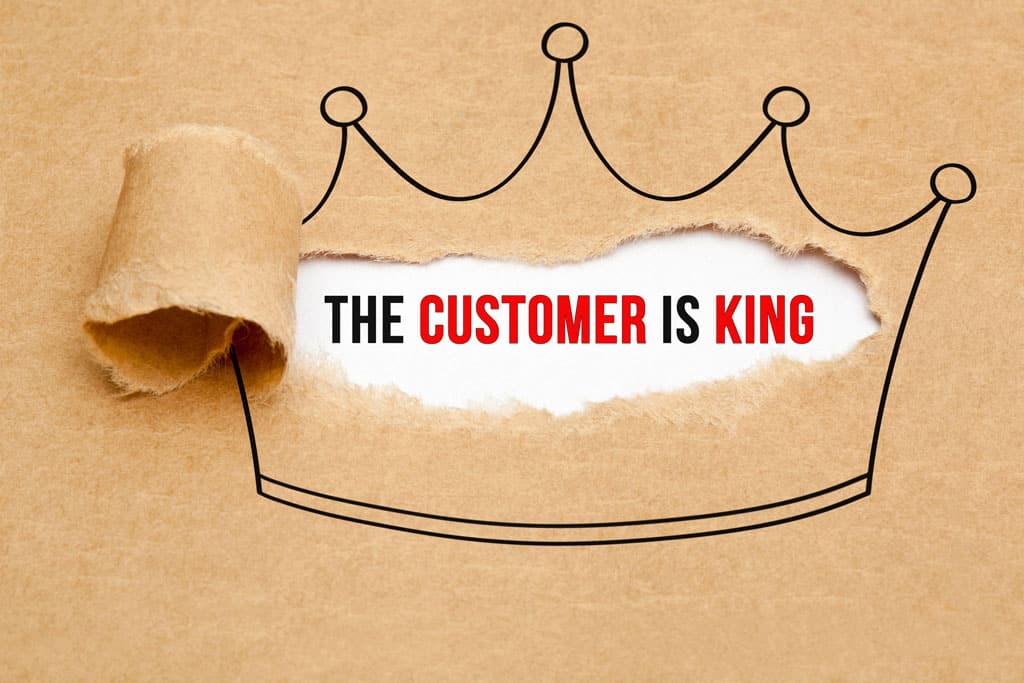Royal treatment: Elevating performance with a customer-centric approach

The historical context and a sporting example of a customer lead approach.
The phrase “the customer is king” was popularized in the early 1900s by retail legends Harry Gordon Selfridge, John Wanamaker, and Marshall Field. While it’s true that customer expectations and behaviour can make or break a business, they’re not the only voices you need to listen to. Stakeholder management goes beyond just your customers—it’s about recognizing and addressing the needs, concerns, and interests of everyone involved. This includes employees, shareholders, suppliers, partners, regulators, and anyone connected to or impacted by your company’s success.
According to the Project Management Institute, everything you do—or don’t do—sends a signal to your stakeholders about what they can expect from you in the future. It’s essential to keep stakeholders, especially customers, in the loop and consistently manage their expectations to achieve success. By setting clear guidelines for success or failure, the company can effectively steer these relationships and ensure all expectations are met.
Few do it better than Arsenal Football Club. As one of London’s top football teams, Arsenal seamlessly balances relationships with a diverse range of stakeholders: the London Borough of Islington, local residents, enthusiastic supporters, and even fans with disabilities, just to name a few. At the heart of this is the club’s dedication to creating an outstanding match-day experience, showcased in the meticulous coordination of their Stadium Management Plan. However, Arsenal’s commitment to stakeholder engagement goes far beyond the pitch, reaching into the community and beyond the walls of Emirates Stadium.
One example of this approach is their outside-in initiatives, which focus on community outreach. Arsenal hosts weekly football sessions for adults with learning disabilities, mental health challenges, and children who are deaf or visually impaired. Their efforts are remarkable: during the 2022–23 season, Arsenal in the Community delivered 7,193 sessions across their local and neighbouring boroughs, reaching over 5,000 participants each week. These programs foster health, happiness, and a sense of community connection.
But most businesses fail at genuinely understanding the voice of customers.
Despite Arsenal’s success a study by management firm Qualtrics found a striking gap in perception: while 80% of companies believe they provide superior customer service, only 8% of customers agree. That’s a huge disconnect. “Voice of the Customer” (VoC) comes in here. VoC refers to gathering and analyzing customer feedback on their experiences and expectations. It digs deep into what customers truly need and want.
As I explain in my book Outside In, Inside Out listening to the VoC is crucial because simply meeting contract requirements won’t lead to satisfied or loyal customers. Businesses can turn these insights into actionable data by analyzing customer feedback and gaining a deeper understanding of their audience. The better you know your customers, the more you can foster loyalty, increase retention, and attract new business—ultimately driving revenue growth.
But is the customer always king? Anthony Ulwick, CEO of Strategyn and author of What Customers Want: Using Outcome-Driven Innovation to Create Breakthrough Products and Services, suggests that companies often go about it the wrong way. After 12 years of observing organizations, Ulwick found that asking customers what they want can sometimes lead to poor decisions. Why? Customers often don’t have the expertise to drive innovation—they can ask for tweaks or improvements but rarely deliver the breakthrough ideas businesses need.
Simply fulfilling customer requests can lead to “me-too” products—features competitors already offer. Take the case of U.S. automakers in the 1980s. Ford, Chrysler, and G.M. all heard from customers that they wanted cup holders—something Japanese manufacturers had already been providing. But when American car companies finally added them, there was no competitive edge. Customers merely shrugged and said, “About time.” Had they employed a deeper VoC analysis, the automakers might have avoided this missed opportunity for true innovation.
Managing complex customer needs at European electricity giant EDF Energy.
When dealing with a wide range of stakeholders with complex needs, a systems-based approach can make all the difference. Take EDF Energy, the U.K.’s largest producer of low-carbon electricity. From wind turbines to electric cars and heating solutions, EDF is fully committed to reducing carbon emissions and achieving net-zero goals.
EDF’s high-profile projects, such as Hinkley Point C and Sizewell C, involved long-term nuclear power plant development and attracted significant public and media attention. With so many stakeholders—customers, employees, shareholders, and the public—that need to be kept informed, EDF needed an efficient way to manage communication and engagement from the outside-in, especially before applying for planning permission.
They used a custom-built, user-friendly system that mapped out thousands of diverse stakeholders and customers. This tool helped EDF coordinate communications, track issues, and manage relationships more effectively. They even created “smart categories” to group stakeholders based on their specific needs and interest levels, allowing them to precisely tailor their communication strategies.
As the International Atomic Energy Agency (IAEA) emphasizes, engaging many stakeholders is critical in nuclear power projects. By involving stakeholders in the decision-making process, EDF was able to boost awareness, build trust, and improve communication—key factors that ensure confidence and understanding in the world of nuclear science and technology.
The eight keys to a successful customer-centric approach.
Engaging with customers is critical to getting outside-in input in the strategy development process. It starts by exploring your environment and understanding who your customers are and what they want, but it also includes world-class communications. More specifically, the eight keys to the crown jewels of success include:
- Get to know the kingdom: Start by identifying all your key customers—their needs, interests, expectations, and what truly matters to them. Ask yourself: Who holds the power? Where might agendas clash? Whose decisions will have the most significant impact? Are there hidden motives? Understanding these dynamics is crucial to navigating successful relationships.
- Harness the power of technology: Use A.I. and natural language processing to dig deeper into customer insights. Technology can be a game-changer in complex environments, uncovering valuable information like sentiment analysis that might otherwise be missed. A great example of sentiment analysis in action is Apple. After launching a new iPhone, Apple uses sentiment analysis to gauge customer reactions to specific features by analyzing customer reviews and social media comments.
- Focus on what matters: With multiple customers, prioritization is critical. Decide which customers need your focus first and why. Businesses have limited resources, so you can’t address all customers and their needs at once—choose wisely. For example, giving priority to loyal customers who have been with your business for a long time, can drive significant ROI given repeat purchases.
- Respect cultural differences: When dealing with diverse customers, understanding cultural nuances is essential, especially when you operate in multiple geographies. Consider how communication styles, negotiation tactics, and decision-making processes might differ. Being adaptable to these differences can help avoid misunderstandings and build stronger relationships.
- Set goals you can achieve: Aim for realistic goals, considering your resources—whether it’s time, budget, or labor. Overpromising can lead to disappointment, so focus on delivering more than expected rather than less. In the fashion industry, brands like Boohoo have faced scrutiny for overpromising on ethical practices and underdelivering. Reports of poor working conditions in their supply chain have led to negative publicity and calls for boycotts.
- Stay adaptable: Be ready to pivot when things change. Customer needs may shift, and unexpected challenges can arise. Flexibility and quick communication are vital to keeping customers satisfied when adjustments are necessary. Tesla is a prime example of flexibility, whereby their electric vehicles are designed with modularity, allowing for easy updates and customization. Tesla frequently releases over-the-air software updates that can enhance vehicle performance, add new features, or improve safety.
- Own the outcome: Be accountable to your customers for success—or failure. If things go wrong, take responsibility and address issues head-on. Owning your mistakes builds trust and credibility. Case in point, JetBlue faced a significant crisis on Valentine’s Day in 2007 when an ice storm led to massive flight delays and cancellations, stranding passengers for hours. They managed the situation through the CEO taking responsibility through a public apology, introducing a new Customer Bill of Rights, operational changes, and extensive public engagement. They turned a challenging situation into an opportunity to improve and rebuild trust with their customers.
- Keep the conversation flowing: Regular, clear communication is essential. Keep customers in the loop on product changes or new product launches. Use the proper channels to get your message across, gather feedback, avoid surprises, and make sure everyone stays informed.
Building trust and resilience through managing customer expectations.
I cannot highlight enough the importance of managing customer expectations as part of the outside-in analysis in strategy development. Doing so can help build customer trust and support, which can be critical to royal ascent in business.
Successfully navigating these expectations, in my experience, comes down to two key elements: defining success and failure and then setting and managing expectations. I’ve found that staying connected fuels business resilience. Engaging with customers often helps companies stay abreast of external threats, changing customer needs, and emerging technology trends. As Steve Jobs previously said, “Get closer than ever to your customer. So close, in fact, that you tell them what they need well before they realize it themselves.”
Written by Dr. Lance Mortlock – Author of Outside In, Inside Out – Unleashing the Power of Business Strategy in Times of Market Uncertainty, EY Canada Managing Partner Industrials & Energy, Strategist & Adjunct Associate Professor.
Have you read?
The World’s Best Medical Schools.
The World’s Best Universities.
The World’s Best International High Schools.
The World’s Best Business Schools.
The World’s Best Fashion Schools.
The World’s Best Hospitality And Hotel Management Schools.
Bring the best of the CEOWORLD magazine's global journalism to audiences in the United States and around the world. - Add CEOWORLD magazine to your Google News feed.
Follow CEOWORLD magazine headlines on: Google News, LinkedIn, Twitter, and Facebook.
Copyright 2025 The CEOWORLD magazine. All rights reserved. This material (and any extract from it) must not be copied, redistributed or placed on any website, without CEOWORLD magazine' prior written consent. For media queries, please contact: info@ceoworld.biz








